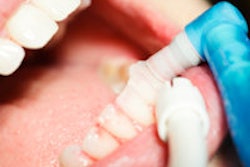
The evolution of the handpiece, one of the most frequently used devices in the dentist's toolkit, has reached a stage where it is now possible to own a disposable one. But how well do they perform?
The ADA has published a laboratory evaluation of two disposable handpieces that have recently hit the market, comparing them not only to one another but to reusable handpieces as well (ADA Professional Product Review, Spring 2013, Vol. 8:2, pp. 13-28). The study examined the Azenic DHP (Azenic) and the Hi-Speed Turbine Handpiece for Single Use-GSY Series (NPH USA).
The basic functionality of both presterilized devices fared equally well when compared with most reusable handpieces in terms of stall torque and power. "Although there is no standard for minimum peak power, the mean peak powers measured in this study are comparable to typical power values seen in the literature for reusable air-driven high-speed handpieces," the researchers at ADA Laboratories wrote.
As is the case with any instrument, the authors were clear in their opinion that the practitioner must judge how comfortable he or she is with either of the devices tested. There are peripheral differences between the two, likely small factors for dentists interested in purchasing one, given their overall similarities in performance. Azenic has a light while the NPH does not; the NPH was quieter.
But the bur-changing system of the NPH may give it a leg up. The testers found that it was "easier to use, may be less damaging to burs, and may offer greater safety for the dental team." There is also the matter of efficiency, and the NPH came out on top here as well. When tested with the same compressed air pressure, the NPH was more efficient than the Azenic. That makes the former device a better bet in situations in which compressor capacity is low, such as mobile operations, the testers noted.
The evaluators had an extensive checklist of characteristics to compare in the lab setting:
Weight and balance: The combined weight of the NPH and its coupler (necessary for operation) was significantly more than the Azenic at 59 g compared with 17 g.
Dimensions: While the maximum head diameter was identical, "the Azenic has a smaller projection length," giving it a larger visibility angle, "which, with all other variables being equal, makes visibility of the operative site more difficult, the researchers wrote.
Noise: The evaluators recommended that dentists wear ear protection when using the Azenic in clinical practice, although there are situations when it is recommended for the NPH as well.
Insertion force and static and dynamic extraction force needed for bur exchanges: The NPH's push-button spring-type, metallic chuck precluded the need for the insertion test and it was easy to use. For the Azenic, however, "it was sometimes difficult to manually push a dental bur into" it, the researchers noted.
Torque and power characterization: While the Azenic had slightly higher peak power, it was not statistically significant.
Efficiency: The Azenic used more air consumption.
There were negligible differences between the two in some categories: speed, eccentricity (how much of its orbit deviates from a perfect circle), stall torque, and performance parameters after simulated use.
Overall, both were given passing grades. "Both handpieces appear to offer an acceptable alternative to reusable air-driven high-speed handpieces and could be considered for clinical use as provider judgment may warrant," the researchers concluded.



















